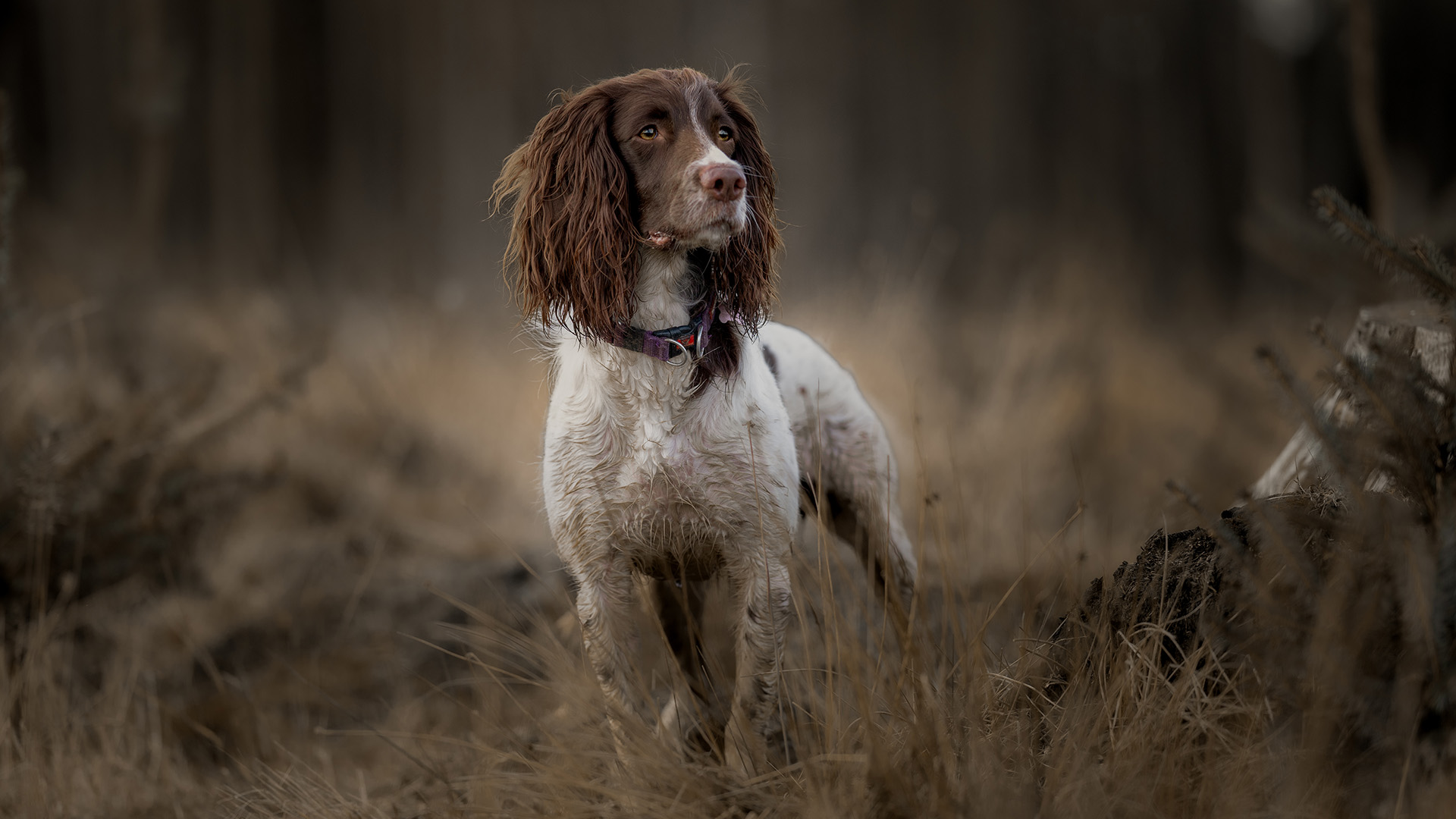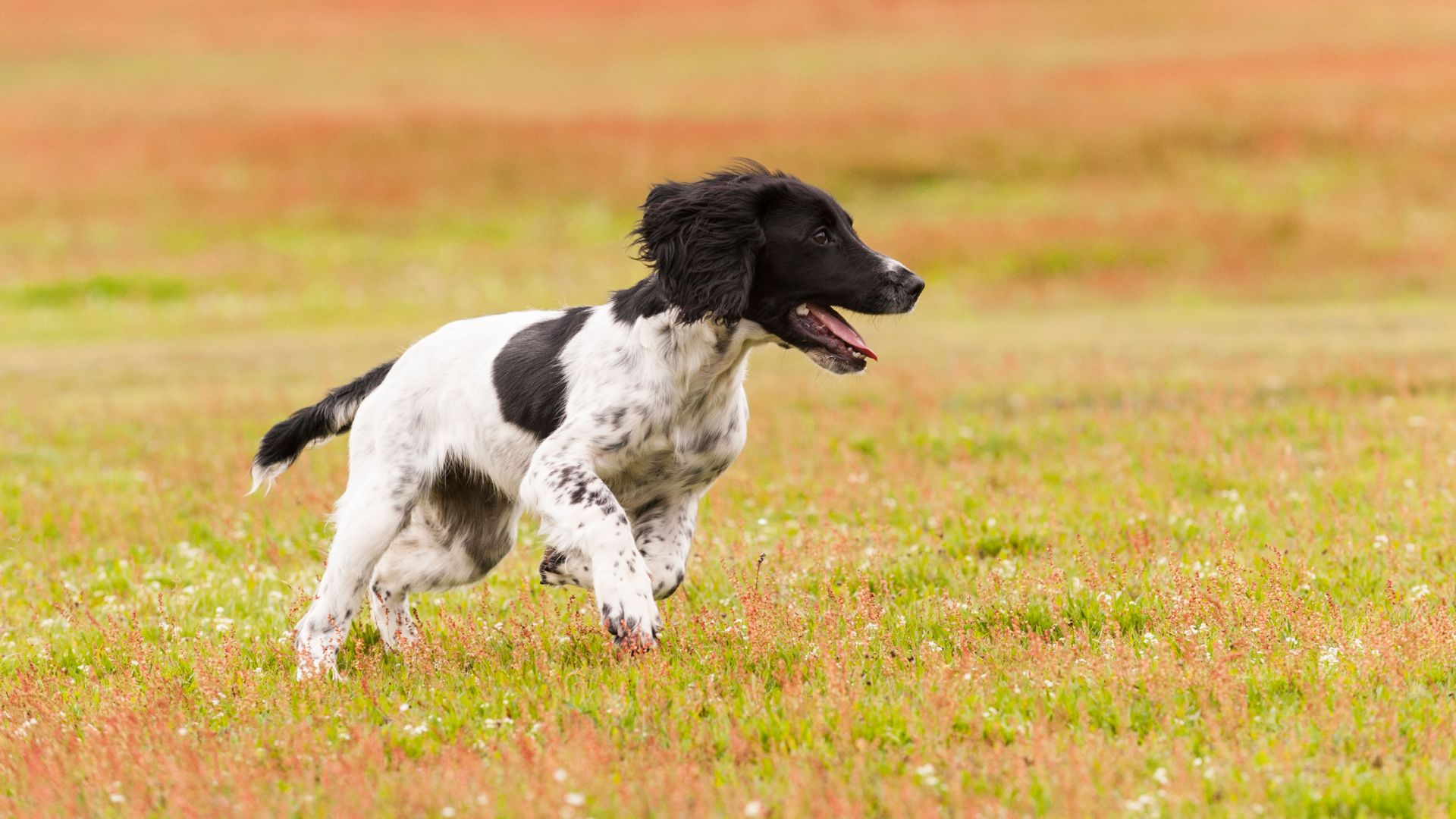

Life expectancy: 12–14 years
Size: 20in (male); 19in (female)
Coat: medium-length topcoat and short undercoat
Temperament: friendly, playful, obedient, active, intelligent
Exercise needs: At least two hours daily
Origin/native country: England
The English Springer Spaniel was originally bred as a high-performance gundog, used to flush and retrieve game. They earned their name as they would “spring” forwards to flush game into nets, and later towards guns – earning them a seat at the table of the best hunting dog breeds.
They’re closely related to Welsh Springer Spaniels and English Cocker Spaniels – in fact, over a century ago, Springers and Cockers would come from the same litter, with their size and conformation used to decide which type of spaniel they were. In 1902, the Kennel Club recognised English Springer Spaniels as a distinct breed. The American Kennel Club followed suit in 1910.
Their heritage means that these fun-loving dogs have plenty of energy, but they also make one of the best family dogs. They’re highly trainable and strive to please their owners, so it’s no surprise that they’ve become one of the most popular breeds.
However, they’re not without their challenges. Let’s take a closer look at English Springer Spaniels, with expert advice from vet Dr Rebecca MacMillan.
Do English Springer Spaniels shed?
English Springer Spaniels do shed, so they’re not considered to be a hypoallergenic breed.
Dr MacMillan explains: “Springer Spaniels shed moderate amounts all year round, but this can be a bit heavier in spring and fall.”
You can’t prevent shedding, but regular brushing helps to remove loose hairs as well as preventing tangles and matting.
What grooming needs does an English Springer Spaniel have?
Springers have medium-length fur and a double coat – this means it’s made up of two layers. The top layer is slightly longer and often wavy, while the bottom layer is much softer and shorter. This double layer works to waterproof and weatherproof your trusty spaniel – harking back to their days spent working in the field.
Because of this, English Springer Spaniels need “a fair bit of maintenance” to keep their coats in tip-top condition, says Dr MacMillan, adding: “They will need brushing two or three times a week to prevent tangles in their long, feathery edges.”
Another option is to have your spaniel’s coat clipped short all over, sometimes referred to as a “puppy-cut”.
Dr MacMillan explains: “This can make things easier to manage at home, but may mean a trip to the groomers every couple of months, unless you can do it yourself.
“Even if you choose to keep your dog’s coat natural,” Dr MacMillan says, “you should still trim the fur between their toes to prevent matting and to reduce the risk of grass seeds getting stuck in their paws.”

Are English Springer Spaniels easy to train?
English Springer Spaniels are super-intelligent dogs, and they’re quick to learn. Thanks to their working heritage, they enjoy mental stimulation and are real people-pleasers.
“Springers are very clever and eager to please, so they are relatively straightforward to train,” agrees Dr MacMillan. “The main issue is that they are a high-energy breed, and they can get bored easily, which can make them distractible. Keep sessions short, with plenty of praise and treats to keep them on task.”
Consistent training from a young age is key and will allow you to channel their energy into something positive, keeping them motivated and avoiding boredom. Remember to place importance on recall training – their hunting instincts means they can have a high prey drive, so keep their focus on you while on walks.
Do English Springer Spaniels bark a lot?
English Springer Spaniels aren’t inherently more vocal than other breeds, but Dr MacMillan warns they can be prone to separation anxiety and boredom if they don’t have enough mental and physical stimulation.
“This may lead to excessive barking,” she explains. “Keeping your Springer well-exercised and making sure they have had the right socialization and training can prevent these problems.”

English Springer Spaniel common health problems
Just as with many pedigree dog breeds, the English Springer Spaniel can be prone to certain health issues. Ear issues are frequently reported by owners.
“I see a lot of Springers with ear issues, including ear infections and stuck grass seeds.” confirms Dr MacMillan. “Their large, floppy ears trap moisture and heat, making them more prone to infections. Ear flare-ups can also be due to underlying skin allergies, which are often seen in this breed.”
Elbow and hip dysplasia can also be common joint abnormalities in Springers. If left untreated, these can lead to arthritis. Signs of hip or elbow dysplasia can include lameness, limping, an abnormal gait or swelling around the joint.
“Reputable breeders should health screen their dogs before mating them to reduce the risk of passing these inherited conditions on to their puppies,” explains Dr MacMillan.
“Springer rage syndrome” is a scary-sounding condition some potential owners come across when Googling, but Dr MacMillan reassures that it is “actually quite rare”.
“Affected dogs have sudden, out-of-the-blue episodes of aggression,” she says. “It is an inherited condition, so breeders should not mate dogs that display symptoms.”
Should I buy an English Springer Spaniel?
If you’re looking for a super-friendly dog breed that can keep up with your active lifestyle, an English Springer Spaniel could be a great fit for you. While they do need plenty of exercise, they are obedient and quick to learn, so the right training early on will pay dividends. And don’t forget to make sure you can dedicate time to their grooming needs to ensure their glossy coat stays in tip-top condition.
They’re known for being kind-hearted and gentle with children, too, so they’re a great fit for an outdoorsy family. Just make sure to place a focus on early training and socialization – with children and other dogs – and you’ll have a best friend for life.
Read next: Facts about English Springer Spaniels
Edited by Georgia Guerin.







